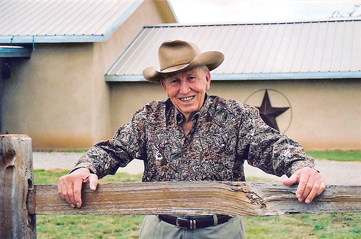|
Vol. 231 No. 5 |
 |
|
| NELL L. BENTON, ASSOCIATE EDITOR |
Hellfighter: The legacy of Coots Matthews
When seeking the perfect topic for our inaugural “Innovative Thinkers” column, I decided: what better person to feature than the legendary E. O. “Coots” Matthews? His passing on March 31 marked the end of an era of the good ol’ boys who worked hard, played hard and made their mark in history by raising hell in the oil fields.
 |
Coots Matthews at his ranch in La Pryor, Texas.
|
|
Few people could say that their life’s work inspired a John Wayne movie. Coots Matthews, oilfield firefighter and founding partner of well control company Boots & Coots, was, by all accounts, a force to be reckoned with. A Texan born and raised, Coots Matthews was one of those people who struck an impression in everybody who met him. Bold, brash and never shy about voicing an opinion, Matthews changed the course of the well control industry and defined what it meant to be a tried-and-true hellraiser.
Just as a sea of high waves is to a surfer, the world of oilfield fires was to Matthews. He became a master in the challenging—and dangerous—field of extinguishing oilfield fires through a variety of techniques, including depleting the oxygen levels of a fire through detonating dynamite.
The fearless and audacious spirit, personified by Matthews, along with partners Asger “Boots” Hansen and Paul “Red” Adair, inspired the 1968 movie Hellfighters. Aside from providing the character bases for Hellfighters’ heroes, all three were technical advisors for the film, which starred John Wayne as Adair-based Chance Buckman.
The passion that drove Matthews began long before the 1978 founding of Boots & Coots. Matthews was a tailgunner during World War II for the US Army. After working at Halliburton in the late 1940s, Matthews took a job with Red Adair as a firefighter—a position that led him to battle some of the world’s most illustrious oilfield fires. This job also led him to meet future business partner Boots Hansen.
Matthews worked with different crews on controlling and extinguishing some of history’s most noted fires, including “The Devil’s Cigarette Lighter” in Gassi Touil, Algeria in 1962. Near the end of the Persian Gulf War, Matthews, Adair and Hansen led crews in extinguishing over 30% of the 700 fires set by the retreating Iraqi soldiers.
In 1978, Matthews and Hansen left the Adair Company and formed Boots & Coots. The name came from the duo’s infamous nicknames. The decision to place Hansen’s moniker first resulted from a single coin toss, with one side labeled “Boots and Coots,” and one side “Coots and Boots.” Hansen won the coin toss, and the story goes that Matthews always stood by the fact that his name came second only because “Boots” came before “Coots” in the alphabet.
Described as a mix of logic and fine-tuned instincts, Matthews brought a whole new level of pride—and fighting spirit—to the field of firefighting. He once said, “An engineer’s not going to put his hands on a fire, but he thinks he’s so much smarter than us ... And if they ever get a computer to cap a goddang oil well, I guess I’ll be out of business. But I ain’t shakin’ in my boots over it.” Richard Hatteburg, senior well control specialist at Boots & Coots and long-time friend and employee of Matthews, explained, “He was as country as a wagon wheel and never met a stranger. He could talk to the president of BP or a roughneck and talk to either one just the same.” This open attitude earned Matthews friendships around the world. As is the nature of the business, Matthews was called at all hours of the night and would have to be at the site of a blowout as soon as possible. This led him all across the globe: He even traveled round-trip between the US and Europe within 24 hours on two occasions.
Despite his hands-on approach to his career, Matthews saw an opportunity in the well control field, where the role of technology was a burgeoning arena. Throughout his 50-plus-year career, Matthews pushed the advancement of pressure and blowout control technologies. As Hatteburg explained, “No two wells are the same. You have to get in and evaluate the situation. Coots would look into each situation as something new and would never just jump into it.” Though Hansen and Matthews sold Boots & Coots to employees in 1994, Matthews continued to advise well control specialists until his death at the age of 86.
Times have changed since the “hellfigher” days. Due to technology, the number of well fires has gone down significantly. Their level of severity has also decreased. The approach to well control has become a science of its own. In an industry where peril and the unknown are just part of the job, the words of Coots Matthews explain it all: “You respect the things you fear,” Matthews would say, “and that respect can save your life.”
As we pay our memorial tribute to Coots Matthews, a new generation of well control specialists are working day and night to control the well in the Gulf of Mexico after the sinking of the Deepwater Horizon semisubmersible. We keep in our thoughts all of those affected by this tragedy and wish them peace, comfort and strength during this very difficult time. 
|




